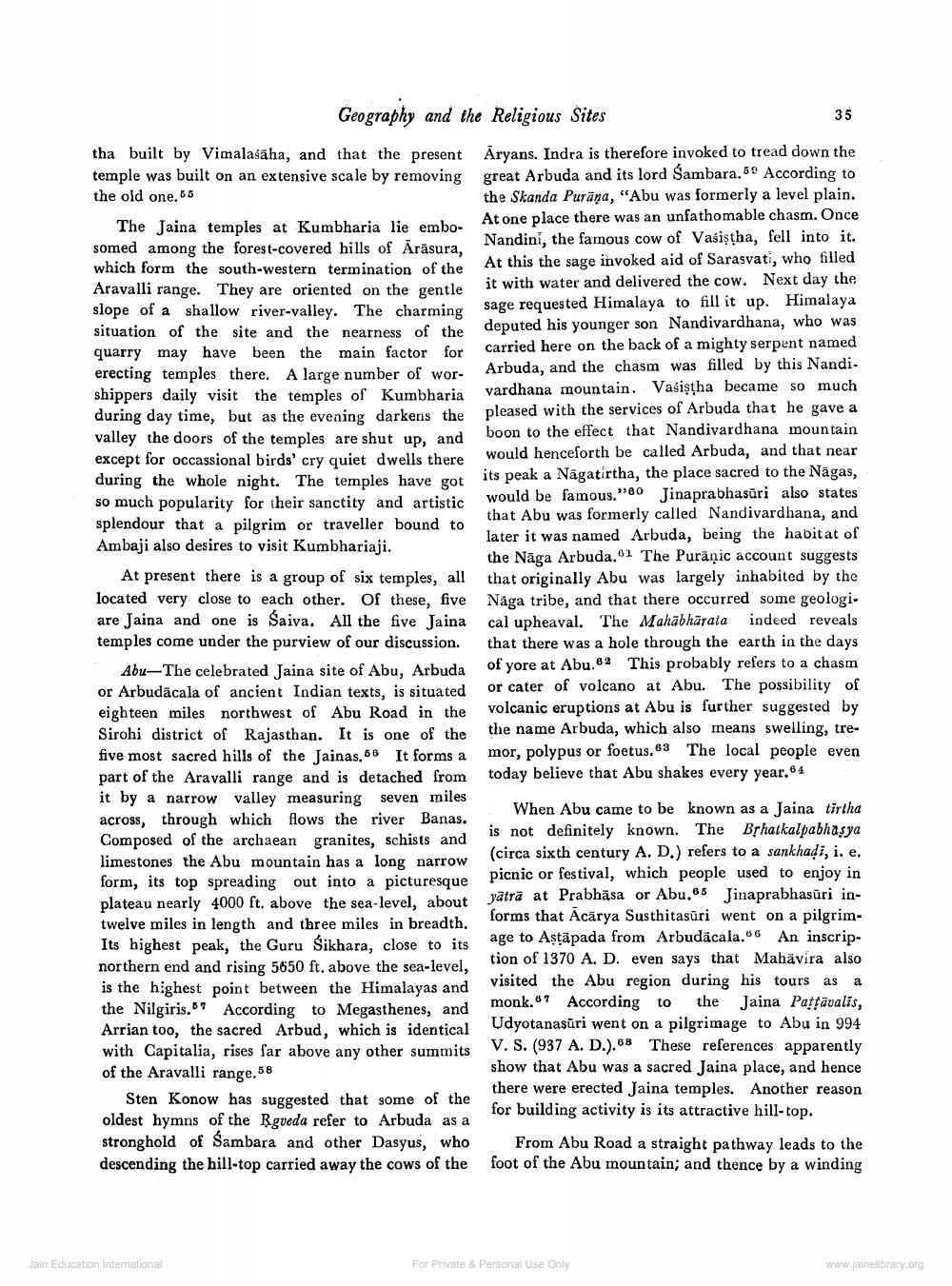________________
Geography and the Religious Sites
tha built by Vimalasaha, and that the present temple was built on an extensive scale by removing
the old one. 55
The Jaina temples at Kumbharia lie embosomed among the forest-covered hills of Ārāsura, which form the south-western termination of the Aravalli range. They are oriented on the gentle slope of a shallow river-valley. The charming situation of the site and the nearness of the quarry may have been the main factor for erecting temples there. A large number of worshippers daily visit the temples of Kumbharia during day time, but as the evening darkens the valley the doors of the temples are shut up, and except for occassional birds' cry quiet dwells there during the whole night. The temples have got so much popularity for their sanctity and artistic splendour that a pilgrim or traveller bound to Ambaji also desires to visit Kumbhariaji.
At present there is a group of six temples, all located very close to each other. Of these, five are Jaina and one is Saiva. All the five Jaina temples come under the purview of our discussion.
Abu-The celebrated Jaina site of Abu, Arbuda or Arbudacala of ancient Indian texts, is situated eighteen miles northwest of Abu Road in the Sirohi district of Rajasthan. It is one of the five most sacred hills of the Jainas. 56 It forms a part of the Aravalli range and is detached from it by a narrow valley measuring seven miles across, through which flows the river Banas. Composed of the archaean granites, schists and limestones the Abu mountain has a long narrow form, its top spreading out into a picturesque plateau nearly 4000 ft, above the sea-level, about twelve miles in length and three miles in breadth. Its highest peak, the Guru Sikhara, close to its northern end and rising 5650 ft. above the sea-level, is the highest point between the Himalayas and the Nilgiris. According to Megasthenes, and Arrian too, the sacred Arbud, which is identical with Capitalia, rises far above any other summits of the Aravalli range. 58
Sten Konow has suggested that some of the oldest hymns of the Rgueda refer to Arbuda as a stronghold of Sambara and other Dasyus, who descending the hill-top carried away the cows of the
Jain Education International
35
Aryans. Indra is therefore invoked to tread down the great Arbuda and its lord Sambara. 59 According to the Skanda Purana, "Abu was formerly a level plain. At one place there was an unfathomable chasm. Once Nandini, the famous cow of Vasistha, fell into it. At this the sage invoked aid of Sarasvati, who filled it with water and delivered the cow. Next day the
sage requested Himalaya to fill it up. Himalaya deputed his younger son Nandivardhana, who was carried here on the back of a mighty serpent named Arbuda, and the chasm was filled by this Nandivardhana mountain. Vasistha became so much pleased with the services of Arbuda that he gave a boon to the effect that Nandivardhana mountain would henceforth be called Arbuda, and that near its peak a Nagatirtha, the place sacred to the Nagas, would be famous."60 Jinaprabhasūri also states that Abu was formerly called Nandivardhana, and later it was named Arbuda, being the habitat of the Naga Arbuda.61 The Puranic account suggests that originally Abu was largely inhabited by the Naga tribe, and that there occurred some geologi. cal upheaval. The Mahabharata indeed reveals that there was a hole through the earth in the days of yore at Abu.62 This probably refers to a chasm or cater of volcano at Abu. The possibility of volcanic eruptions at Abu is further suggested by the name Arbuda, which also means swelling, tremor, polypus or foetus. 63 The local people even today believe that Abu shakes every year.64
When Abu came to be known as a Jaina tirtha is not definitely known. The Brhatkalpabhasya (circa sixth century A. D.) refers to a sankhadi, i. e. picnic or festival, which people used to enjoy in yatra at Prabhasa or Abu.65 Jinaprabhasūri informs that Acarya Susthitasuri went on a pilgrimage to Aṣṭāpada from Arbudacala. An inscription of 1370 A. D. even says that Mahavira also visited the Abu region during his tours as a the Jaina Pattavalis, monk.67 According to Udyotanasuri went on a pilgrimage to Abu in 994 V. S. (937 A. D.).68 These references apparently show that Abu was a sacred Jaina place, and hence there were erected Jaina temples. Another reason for building activity is its attractive hill-top.
From Abu Road a straight pathway leads to the foot of the Abu mountain; and thence by a winding
For Private & Personal Use Only
www.jainelibrary.org




